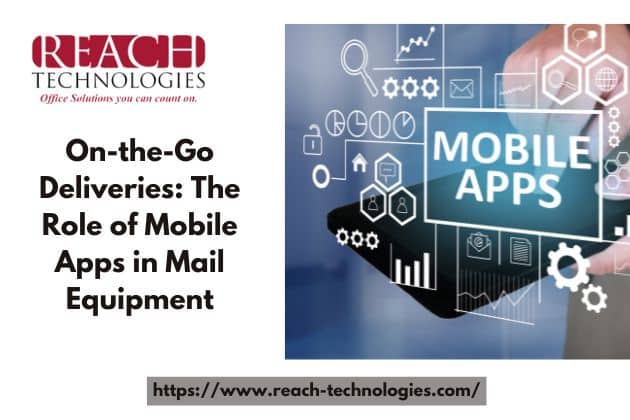Introduction: The Digital Shift in Mail Logistics
In today’s rapidly evolving logistics landscape, the integration of mobile technology with mail equipment has emerged as a transformative force. As global demand for faster, smarter, and more trackable deliveries rises, mobile apps have redefined how mail systems operate, offering unprecedented levels of efficiency, accuracy, and customer satisfaction. Mobile applications now serve as the backbone of on-the-go delivery operations, streamlining workflows from warehouse dispatch to the final mile.
The Convergence of Mobile Apps and Modern Mail Equipment

Mail equipment has traditionally included physical components like sorters, conveyors, barcode scanners, and labeling machines. However, modern logistics now fuses these components with smart mobile applications that offer real-time visibility and remote control capabilities.
Real-Time Tracking and Status Updates
One of the most crucial benefits of mobile apps in mail logistics is real-time tracking. Delivery personnel equipped with mobile-integrated scanners and GPS-enabled devices can send instant updates to the system. This not only improves internal operations but also enhances transparency for end users awaiting their parcels.
Benefits include:
-
Live package location visibility
-
Estimated time of arrival updates
-
Instant delivery confirmation with e-signatures
-
GPS and geofencing for optimized routing
Streamlined Sorting and Dispatch Through App Integration
With mobile apps, mail sorting has become significantly more efficient. Using smartphones or tablets with built-in QR and barcode scanning capabilities, warehouse teams can easily:
-
Identify packages
-
Allocate to the appropriate zone
-
Trigger automated sorting based on delivery route or urgency
The software syncs with the centralized mail management systems, ensuring data consistency across the entire delivery chain.
Enhanced Communication and Coordination
Internal communication tools built into mobile apps allow drivers, warehouse personnel, and logistics managers to remain connected at all times. This allows for:
-
Instant rerouting if an address changes
-
Delivery priority shifts based on real-time traffic or customer demand
-
Swift issue resolution when packages are delayed or misplaced
The seamless communication enables agile decision-making, essential in modern last-mile delivery.
Mobile App Integration with IoT Devices
As Internet of Things (IoT) becomes increasingly mainstream in logistics, mobile apps play a critical role in bridging hardware and software ecosystems. Sensors embedded in mail equipment provide live data feeds to mobile platforms, enabling:
-
Monitoring of equipment health and performance
-
Instant alerts on system failures or overloads
-
Remote diagnostics and troubleshooting via app interfaces
This level of control ensures zero downtime and boosts overall productivity.
Smart Routing and Dynamic Scheduling
Mobile apps in mail logistics now leverage AI-powered algorithms for routing and scheduling. These intelligent systems analyze:
-
Real-time traffic data
-
Delivery time windows
-
Weather conditions
-
Historical delivery patterns
They then deliver dynamic route plans directly to the courier’s device, optimizing efficiency and reducing fuel costs.
Key advantages include:
-
Reduced delivery times
-
Fewer missed deliveries
-
Improved resource allocation
-
Enhanced carbon footprint management
Contactless Deliveries and Security Enhancements
In a post-pandemic world, contactless delivery is no longer a luxury but a necessity. Mobile apps now come equipped with features like:
-
Remote signature collection
-
Photo proof of delivery
-
NFC-enabled package confirmation
-
Digital ID verification
Security protocols are also fortified through end-to-end encryption and multi-factor authentication, safeguarding user and package data from breaches.
Data Analytics and Performance Metrics
The vast data collected through mobile apps provides invaluable insights for logistics companies. Integrated dashboards offer:
-
Delivery success rates
-
Route efficiency comparisons
-
Equipment utilization metrics
-
Courier performance tracking
These insights empower managers to make data-driven decisions that boost operational efficiency and enhance customer experience.
Cost Reduction Through Mobile-First Solutions
Adopting mobile apps significantly reduces operational costs by:
-
Eliminating paperwork and manual data entry
-
Lowering dependency on bulky desktop systems
-
Enhancing route efficiency to reduce fuel use
-
Minimizing errors and associated rectification costs
Companies that embrace mobile-first logistics ecosystems see not just faster deliveries but also higher margins.
Customer-Centric Experience with Mobile Engagement
From the end-user perspective, mobile apps offer a more personalized, transparent, and engaging delivery experience. Customers benefit from:
-
Instant order tracking
-
Two-way communication with delivery agents
-
Real-time rescheduling options
-
Notifications for each delivery milestone
Customer satisfaction has become a key differentiator, and mobile apps have become the essential touchpoint for this interaction.
Future Trends: AI, Augmented Reality, and Blockchain Integration
The next phase of innovation in mobile mail logistics is unfolding with:
-
AI-based chatbots for customer support
-
Augmented reality tools to assist in package sorting and equipment maintenance
-
Blockchain for tamper-proof tracking of high-value or sensitive parcels
These technologies, when integrated into mobile platforms, will push the industry toward unprecedented levels of automation and security.
Conclusion: The Role of Reach Technologies in Advancing Mobile-Integrated Mail Equipment
By combining powerful mobile platforms with intelligent mail equipment, Reach Technologies helps logistics companies drive performance, elevate customer experiences, and stay future-ready. As mobile apps continue to shape the future of mail operations, we remain committed to delivering innovation that delivers results.
